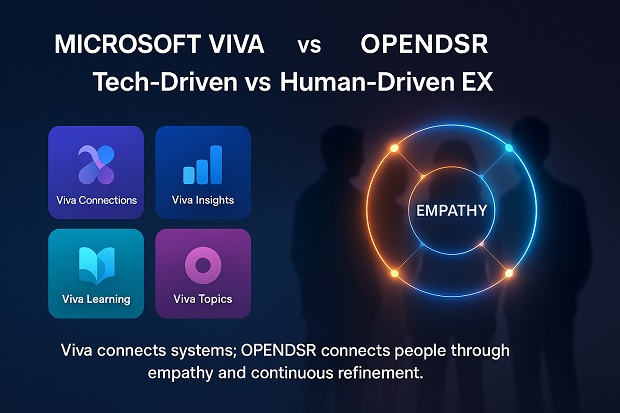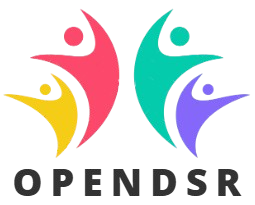
IBM EX Index vs OPENDSR: Turning Insight into Action
IBM EX Index vs OPENDSR: Turning Insight into Action Introduction: The New Frontier of Employee Experience
Over the past decade, organizations have invested heavily in measuring employee experience (EX) — understanding what drives engagement, satisfaction, and performance.
Among the most influential frameworks is the IBM Employee Experience Index (EX Index), developed to quantify how people feel at work and what influences their performance.
But while the IBM EX Index helps companies measure experience, the question remains: What happens next?
Data without design often leads to stagnation. Metrics without movement fail to inspire change.
And that’s where OPENDSR redefines the game — moving organizations from insight to action, from measurement to moment-by-moment transformation.
IBM’s Employee Experience Index was introduced as part of its Smarter Workforce Institute research to help organizations understand the five dimensions that define a positive experience at work.
These five dimensions include:
Dimension Definition Example Indicator Sense of Belonging Feeling accepted and included at work “I feel like I am part of the team.” Purpose The alignment between personal and organizational goals “I understand how my work contributes to company success.” Achievement Feeling of accomplishment and growth “I am recognized for my contributions.” Happiness Day-to-day emotional satisfaction “I enjoy my daily work activities.” Vigor Energy and motivation to perform “I feel energized at work.”IBM’s model combines these factors into a single composite score — the EX Index — which can be benchmarked across teams, industries, and geographies.
It’s a powerful diagnostic tool that offers leaders a snapshot of how people feel at work.
However, it remains primarily analytical and retrospective. It helps organizations understand the “what” of employee experience but not necessarily the “how” to evolve it dynamically.
While the IBM EX Index is data-rich, it is also data-bound.
The framework’s strength — its structured measurement — is also its limitation in a world that requires real-time adaptability.
Key Challenges with Traditional EX Indices-
Lag in Action:
Feedback is often collected quarterly or annually, which delays organizational response. -
One-Dimensional Insights:
Surveys measure perceptions but rarely capture the why behind employee feelings. -
Lack of Behavioral Context:
Metrics can show disengagement but cannot reveal the underlying friction points in workflows or culture. -
Top-Down Interpretation:
Data often flows to leadership dashboards but doesn’t empower employees or teams to self-correct.
In essence, traditional EX indices provide mirrors, not motors. They show the state of experience but don’t power continuous improvement.
OPENDSR — From Measurement to MovementOPENDSR (Open Design System for Renewal) was built to close this gap — transforming static diagnostics into living systems of experience design and real-time adaptation.
Where the IBM EX Index stops at insight, OPENDSR begins with empathy and action.
It enables organizations to listen, interpret, and act continuously, turning every feedback moment into a design opportunity.
The Core Philosophy: Experience as a SystemOPENDSR treats employee experience not as an event or survey result but as a living system of interactions, emotions, and feedback loops.
Its foundation rests on four pillars:
Pillar Focus Outcome Open Platform Integrates across tools, workflows, and data sources Seamless interoperability and shared insights Empathy-Led Navigation Prioritizes human emotions and meaning Humanized leadership and responsive action Design Standards Translates EX strategy into actionable templates Consistency and scale in improvement efforts Real-Time Intelligence Embeds analytics and continuous feedback Adaptive, responsive EX systemsThis approach allows OPENDSR to move beyond surveys — capturing continuous signals from workplace interactions, conversations, collaboration tools, and digital behaviors to shape responsive experiences.
IBM EX Index vs OPENDSR — A Comparative Analysis Dimension IBM EX Index OPENDSR Core Purpose Measure employee sentiment Design, refine, and elevate human experience Model Type Fixed diagnostic framework Adaptive design system Feedback Mode Periodic survey-based Continuous listening and real-time signals Output Composite EX score Dynamic EX dashboard with actionable insights Action Mechanism Post-survey initiatives In-platform nudges, design loops, and live interventions Data Flow Top-down reporting Bi-directional — empowering teams and leaders Scope Engagement measurement Systemic experience transformation Time Orientation Retrospective Predictive and ongoingIn simple terms, IBM tells you what employees feel, while OPENDSR helps you design how they will feel next.
Turning Insight into Action — The OPENDSR Advantage 1. Real-Time Feedback LoopsTraditional EX tools aggregate responses for later review.
OPENDSR’s embedded real-time feedback loops allow organizations to sense emotional and operational shifts as they happen.
Imagine a manufacturing team where employee fatigue data from IoT sensors correlates with emotional check-ins.
Leaders receive live alerts prompting micro-interventions — adjusting shifts, redesigning workflows, or initiating recovery breaks — within the same week, not next quarter.
Unlike algorithmic dashboards that simply rank engagement, OPENDSR visualizes the emotional fabric of the workplace.
It identifies why people feel disengaged — perhaps due to low role clarity, missing recognition, or leader empathy gaps — and provides action cues for improvement.
For instance:
“Team empathy score dropped 18% after a workflow automation rollout — consider a ‘listening huddle’ to clarify job role changes.”
This kind of contextual empathy intelligence transforms raw data into relational awareness.
3. Design-Centric InterventionOPENDSR integrates design thinking with behavioral analytics.
Each identified challenge triggers micro-design interventions — templates, conversation guides, or habit loops that address the issue directly.
Where IBM EX Index provides insight, OPENDSR delivers intervention.
Stage IBM EX Index OPENDSR Equivalent Measure Engagement Annual survey Continuous pulse signals Analyze Data Central HR dashboards Distributed analytics across teams Recommend Actions Reports to management In-app nudges & real-time playbooks Track Change Quarterly updates Instant visual dashboards 4. Integration and ScalabilityOPENDSR connects seamlessly with platforms like Workday, Microsoft Teams, Slack, and CorporateOne to embed EX intelligence where work happens.
This integration enables “experience in flow” — feedback and response systems that operate inside the employee’s digital workspace rather than outside of it.
Thus, instead of leaders checking a separate report portal, OPENDSR delivers EX nudges directly in context, for example:
“Your team’s recognition pulse dropped this week — try a gratitude circle in your next meeting.”
Philosophical Shift — From Index to EcosystemAt its core, OPENDSR represents a philosophical shift from measurement to movement.
Old Paradigm (IBM EX Index) New Paradigm (OPENDSR) Experience as a metric Experience as a living system Periodic survey Continuous sensing Data for insight Data for design Centralized ownership Distributed co-creation Employee as respondent Employee as designer of their own experienceThis shift mirrors how customer experience evolved from satisfaction surveys to CX ecosystems that personalize every interaction.
OPENDSR applies the same logic to human-centered organizational design.
Let’s illustrate the difference through a practical example.
Context:
A global IT company using the IBM EX Index finds that “Purpose” and “Recognition” scores are declining across mid-level managers.
-
HR creates a 10-page report summarizing trends.
-
Leadership teams discuss interventions for the next quarter.
-
Actions (recognition programs, communication workshops) launch three months later.
-
Re-measurement shows marginal improvement.
-
The system detects sentiment dips in “Purpose” signals within two weeks.
-
A contextual nudge appears in managers’ dashboards:
“Team sentiment shows decline in clarity — consider revisiting project goals in this week’s meeting.”
-
Design playbooks guide them through micro-actions: clarity conversations, recognition messages, and one-on-one empathy mapping.
-
The experience dashboard reflects improvement dynamically, creating a feedback-renewal cycle within days.
This is living design, not static data.
The Future of EX — Predictive, Personalized, and HumanAs organizations enter the AI era, the next frontier is predictive EX — where systems not only measure and respond but also anticipate human needs.
OPENDSR’s architecture allows for human-AI collaboration in experience design:
-
AI predicts friction zones using pattern recognition.
-
Human leaders apply empathy to interpret context and co-design responses.
-
The system learns continuously, refining both accuracy and emotional relevance.
This synergy ensures that technology amplifies humanity — not replaces it.
Summary Comparison Aspect IBM EX Index OPENDSR Impact Framework Type Diagnostic Index Human Design System From static metrics to dynamic renewal Primary Focus Understanding engagement Evolving human experience Broader transformation Actionability Post-survey planning Real-time nudges & playbooks Faster, continuous action Emotional Intelligence Implicit Explicit empathy layer Richer understanding Integration Survey platform Cross-system interoperability Workflows become EX channels Time to Change Weeks to months Hours to days Adaptive agility Conclusion — From Insight to ImpactThe IBM EX Index gave organizations a language to measure experience.
It helped humanize data and legitimize emotion in the workplace.
But today’s complexity demands something beyond measurement — an operating system that can feel, respond, and evolve in real time.
That’s what OPENDSR brings to the world of employee experience —
a shift from scores to systems, feedback to flow, and data to design.
By turning insight into action, OPENDSR ensures that organizations don’t just know their people better — they grow with them.








